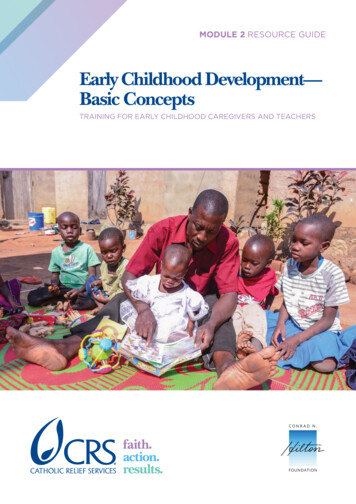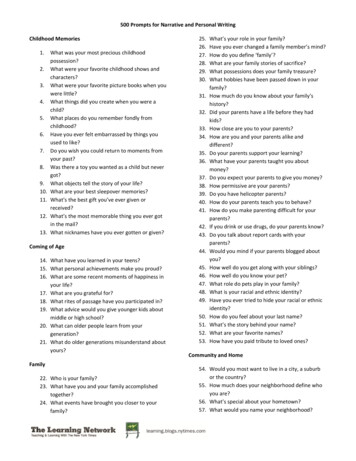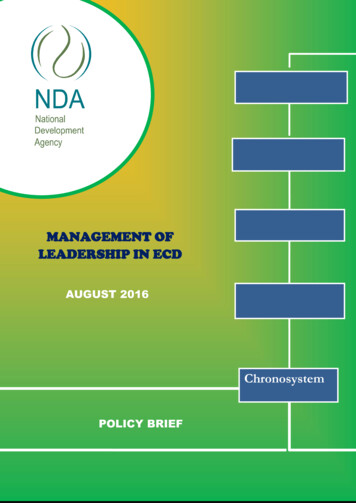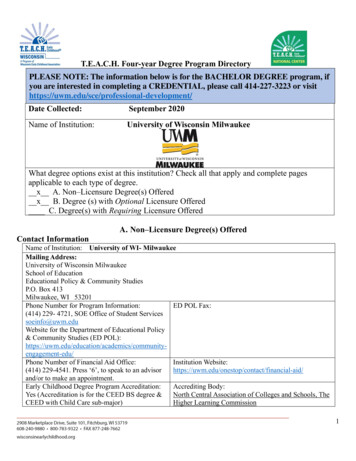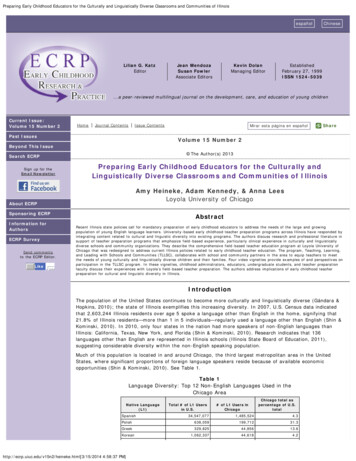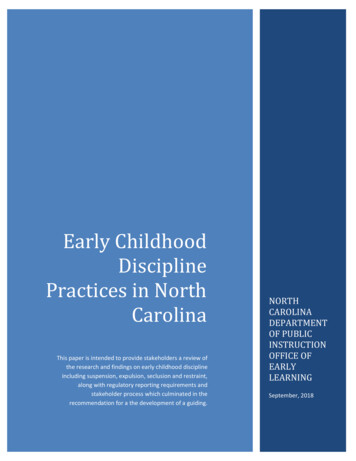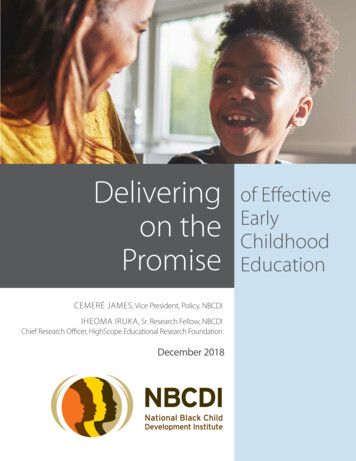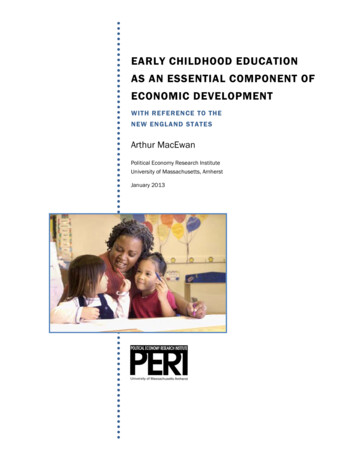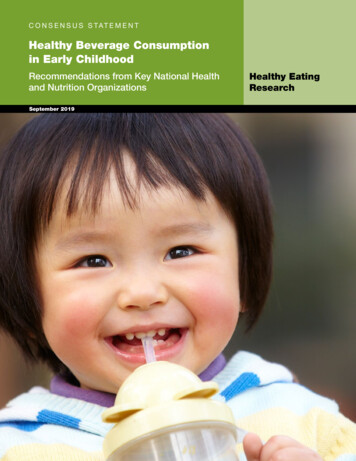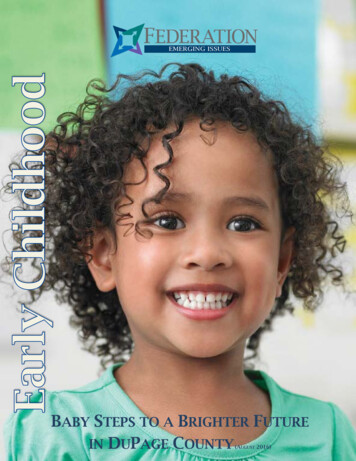
Transcription
Early Childhood-The Steps to a Brighter Future in DuPage CountyBABY STEPS TO A BRIGHTER FUTUREIN DUPAGE COUNTYwww.dupagefederation.org(AUGUST 2016)
Early Childhood-The Steps to a Brighter Future in DuPage CountyTABLE OF CONTENTSExecutive Summary .1Key Findings: . 1Key Recommendations: .2Introduction.1Why are the early years crucial? . 3Data Collection Methodology and Sources . 5Description of Community . 7Findings . 8Population .8Demographics.8Socioeconomic Factors . 9Birth Statistics . 13Child Care & Education . 15Screening Children . 19Child Health Factors .20Community Input and Identification of Priority Issues . 26Parent Surveys . 26Stakeholder Surveys . 27Focus Groups . 27Existing Resources . 29Partner Organizations . 29Community Resource Book . 31DuPage CRIS . 31Home Visiting Services . 31Child Care Resource & Referral Network . 32Partner Plan Act . 32Impact DuPage . 32Conclusions and Areas of Opportunity . 33Appendix A: Acronym Guide . 37Appendix B: DuPage Early Childhood Collaboration Strategic Plan 2016-2019 . 38Appendix C: 0-5 Child Find: Reflecting the Number of Children Reported Screened . 42Appendix D: DuPage County Home Visiting Network Programs . 43References . 46www.dupagefederation.org
Early Childhood-The Steps to a Brighter Future in DuPage CountyEXECUTIVE SUMMARYWhile the Federation has written numerous community profiles this is the first tospecifically outline theearlychildhoodlandscape in DuPage County. Muchresearch has been done on earlychildhood on a national and statelevel but it has not been drilled down“The best way to improve the American workforce inthe 21st century is to invest in early childhoodeducation, to ensure that even the most disadvantagedchildren have the opportunity to succeed alongsidetheir more advantaged peers” James Heckman, Nobel Prize Winnerspecifically to the county level. Withinterventions and funding increasingly desiring a local approach it is critical to provide a baseline ofwhere early childhood stands today in our community.Starting in February of 2016, the Federation assembled the following profile of the early childhoodcommunity in DuPage County, Illinois. Realizing the breadth of data that exists on this population, theFederation sought to aggregate the available information on children under 5 years old in DuPageCounty. The data obtained covers population demographics, birth characteristics, early education,child care capacity, health, as well as parental factors. This profile also seeks to capture some of thefindings within conversations in the early childhood sector across the county. It is intended that thecollection of information within this report creates a detailed picture of early childhood in DuPageCounty, which can assist with efforts in enhancing service coverage and developing strategies andinitiatives for the population. We acknowledge that there is a vast array of strengths, barriers andchallenges within this sector so this profile is not meant to be exclusive, but rather a jumping off pointto begin work on issues we can collectively influence and impact.Key Findings:1. Childcare may not be sufficiently meeting the needs of families. Barriers such asaffordability, hours of operation and location are making it difficult for families to enroll theirchildren in high quality care. There is a particular gap in programming for children ages 0-3with only 24.66% infants and toddlers being served.2. Lack of physical classroom space may be limiting enrollment of high-needchildren. We must expand private/public partnerships to address this lack of supply as it isinterfering with our county’s ability to seek more resources.www.dupagefederation.org1
Early Childhood-The Steps to a Brighter Future in DuPage County3. Linguistic isolation is preventing families from engaging in early childhoodopportunities. In 2013, 6,729 households spoke Spanish at home, and 9,692 spoke othernon-English languages. Nearly 1 in 5 or, 19.5% of children under 5 in DuPage speak Spanish.As a whole, 68.2% of these children speak English. We must be intentional about trainingmulticultural early childhood professionals and developing multicultural community programsthat serve these families.4. ChildhoodpovertyinDuPageiscontinually rising. An estimated 17,351 of67,519 children under 5 are under 200% federalpoverty level (FPL). Within this poverty, ionately affects African American,Hispanic and single mother households.5. Common messaging and a collective agenda is crucial to creating a unified voice.To inform key stakeholders of the specific needs within their early childhood communities wemust first agree on holistic kindergarten readiness measures across the county. Once this hasbeen defined we can gain consensus on a collective agenda.6. While public health is an identified strength of our area, childhood obesity andfood insecurity remain high for children. The food insecurity rate for 2014 in DuPagewas 8.0%, however the rate for children 18 years old and under was 14.6%. In our county in2015, 15.5% of 2-4 year olds participating in the WIC program were obese.7. The transition to kindergarten from early childhood programs is not always assmooth as desired. Within each district, there may be differing cultures and levels ofcommunication between parents, early childhood providers and the school system. All partieswant children to be ready for kindergarten.Key Recommendations:1. To address affordability, hours and lack of childcare slots, programs may need tobe adjusted and/or resources increased from state, federal and private sources.Collaborations should consider evaluating where high quality childcare exists and recruit andidentify resources within targeted communities to meet these gaps or host these complexconversations. Funders may also serve a critical role in supporting high quality programs thatare going above and beyond to meet the needs of families.www.dupagefederation.org2
Early Childhood-The Steps to a Brighter Future in DuPage County2. Public/private partnerships should be convened to identify areas within thecounty that may be suitable for early childhood programs. Working with nontraditional early childhood partners such as community planners and developers, we shouldconsider mapping and assessing the current infrastructure to see where space may beunderutilized that could be built out for early child care.3. Building a qualified early childhood workforce that is trained to serve diversefamilies is critical. Efforts to recruit or train culturally competent staff are underway butcould be enhanced to meet the need.4. To address childhood poverty we must create economic stability for morehouseholds. One way to offset the cost of childcare is to increase the use of Illinois Child CareAssistance Program among eligible families. It provides low-income working parents access toaffordable quality child care. This subsidy helps families to work or to attend school to improvetheir future earning potential.5. In order to demonstrate impact of collaborative work we must agree on commonindicators and domains that establish a baseline. Allocating resources to collaborativework and data analysis is a key driver of this work.6. There are natural interactions with families that could help address foodinsecurity and/or childhood obesity. Early childhood programs, social services andmedical providers may be uniquely positioned to naturally address these issues. Embeddinghunger vital signs within existing practices may be a useful tool.7.To aid in a smoother transition from earlychildhood programs that are private orcommunity based we should be essionals, providers and families have a desire toincreasecommunicationbetweenchildhood system and schools.theearlySome entities aredoing this well and models can be shared.www.dupagefederation.org3
Early Childhood-The Steps to a Brighter Future in DuPage CountyINTRODUCTIONFor decades, protecting and nurturing young children and families in DuPage County has been a toppriority. Organizations that serve these young children are increasingly working across institutional orgeographic boundaries to better meet the complex needs of families. Yet despite these vastimprovements in collaboration a key piece remains the same; there is always a need for enhanced localdata. It is the Federation’s view that the holistic needs of the child must be addressed to truly preparethem for success later in life. We also recognize that the parent is the child’s first teacher andcaregiver, biological or otherwise, and is critical to improving a child’s future outcomes. Therefore thisreport attempts to use this framework to provide a holistic summary of the many influences on achild’s life and the dramatic interplay between systems. We thank the DuPage Foundation and GrandVictoria Foundation for providing the DuPage Federation on Human Services Reform the opportunityto engage in this analysis, as presented in this early childhood profile.DuPage Federation on Human Services Reform was formed in 1995 by a Governor's office initiative asone of five 'learning laboratories' whose role was to demonstrate a new approach to collaborationbetween government and community in the implementation of welfare reform. Since that time, ourrole has appropriately shifted to developing a broad system of supports for vulnerable families, and toimproving the capacity of the human services system to meet increasingly complex needs. TheFederation currently operates five programs 1.The Federation has a broad system of supports for vulnerable populations and provides leadership forchange efforts to improve the welfare in disadvantaged communities. In the early childhood arena, theFederation spearheaded an effort to reform delivery of child support services that substantiallyimproved program collection rates. Today it hosts the DuPage Early Childhood Collaboration, agrassroots collaboration charged with assessing existing resources and planning an agenda to enhancepublic support for early childhood services. The Regional Collaboration’s mission is to ensure thateach and every child enters kindergarten safe, healthy, ready to succeed and eager to learn.It is our hope that this compilation of data in the 2016 DuPage Early Childhood Profile will facilitatelocal dialogue and inform local stakeholders to improve early childhood outcomes. The Federationbelieves that making sure that every child gets the best possible start in life must be everyone’spriority.1Public Benefits training, Early Childhood Regional Collaborative, Language Access Resource Center, HumanServices Planning, and the Open Door program, which provides crisis intervention to families and individuals.www.dupagefederation.org1
Early Childhood-The Steps to a Brighter Future in DuPage CountyThis report would not have been possible without the knowledge of our community leaders. Weexpress sincere thanks to the following contributors:Karen Ayala, DuPage County Health DepartmentBecky Beilfuss, Teen Parent ConnectionShelley Bromberek-Lambert, YWCA Metropolitan ChicagoNicole Cameron, Metropolitan Family Services DuPageDanette Connors, YWCA Metropolitan ChicagoJordan Durrett, DuPage Federation on Human Services ReformTheresa Hawley, Ph.D., ConsultantCandace King, DuPage Federation on Human Services ReformMarjory Lewe-Brady, WeGo Together for Kids/West Chicago School District 33Shelina Manji, M.D., Kid's MD at HomeDeborah J. Manst, M.D., DuPage Federation on Human Services ReformChristine Nicpon, Latino Policy ForumLori Orr, PACT Inc.Marianne Pokorny, YWCA Metropolitan ChicagoChristy Poli, Bensenville School District 2Magdalena Rivota, Regional Office of EducationDarlene Ruscitti, Ed.D., Regional Office of EducationJillian Santora, PACT Inc.Michelle Scharinger, Community Consolidated School District 93Elise Schram, Wheaton/Warrenville Early Childhood CollaborativeLorena Vaughn, DuPage Federation on Human Services ReformThank you to the generous support of our funders, DuPage Foundation, Grand Victoria Foundationand the Alfred Bersted Foundation. Lastly, we would like to thank Lorena A. Vaughn and Deborah J.Manst for all of their work and dedication to completing this profile.www.dupagefederation.org2
Early Childhood-The Steps t o a Brighter Future in DuPage CountyWHY ARE THE EARLY YEARS CRUCIAL? Getting things right the first time is easier and more effective than trying to fix them later. Early childhood matters because experiences early in life can have a lasting impact on laterlearning, behavior, and health. Highly specialized interventions are needed as early as possible for children experiencing toxicstress. Early life experiences actually get under the skin and into the body, with lifelong effects onadult physical and mental health. All of society benefits from investments in early childhood programs. 2All years of a child’s life are important but the early years are critical for brain development that setsthe stage for a child’s entire life. “The early years matter because, in the first few years of life, 700 newneural connections are formed every second. Neural connections are formed through the interactionof genes and a baby’s environment and experiences, especially “serve and return” interaction withadults, or what developmental researchers call contingent reciprocity. These are the connections thatbuild brain architecture – the foundation upon which all later learning, behavior, and health depend.”700 New Neural Connections Per SecondImage source: Conel, JL. The postnatal development of thehuman cerebral cortex. Cambridge, Mass: HarvardUniversity Press, 1959.In addition to creating the brain’s architecture the return on investment during these early years paysdividends.Children involved in early childhood programs go on to earn higher earnings andinvolvement with the criminal justice system and special education programs decreases. Returns on2Center on the Developing Child (2009). Five Numbers to Remember About Early Childhood Development(Brief). Retrieved from on.org3
Early Childhood-The Steps to a Brighter Future in DuPage Countyinvestment are particularly high for at-risk children. Heckman contends, "The real question is how touse available funds wisely. The best evidence supports the policy prescription: Invest in the veryyoung." The benefits have been researched in numerous studies as the chart indicates below with a 4- 9 return for each 1 spent on early childhood. 4 - 9 in Returns For Every Dollar Invested in Early Childhood ProgramsSources: Masse, L. and Barnett, W.S., A Benefit Cost Analysis of the Abecedarian Early Childhood Intervention (2002); Karoly et al., EarlyChildhood Interventions: Proven Results, Future Promise (2005); Heckman et al., The Effect of the Perry Preschool Program on theCognitive and Non-Cognitive Skills of its Participants (2009)www.dupagefederation.org4
Early Childhood-The Steps t o a Brighter Future in DuPage CountyDATA COLLECTION METHODOLOGY AND SOURCESThe DuPage Federation on Human Services Reform (DFHSR) gathered data in a similar fashion to acomprehensive community needs assessment for the early childhood profile. Measured secondarydata was collected from numerous sources and analyzed, and subjective primary data from DuPagecommunities was compiled from local organizations.Secondary DataFor the Early Childhood Profile, the Federation manually collected data from a range of public datarepositories and other secondary sources. Unless otherwise specified, all data reported within theprofile is regarding children under age 5 in DuPage County. Sources included the following: U.S. Census Bureau 2010 Censusand American Community Survey DuPage County Continuum of Care Bureau of Labor Statistics Impact DuPage Illinois Early Childhood Asset Map U.S. Department of Agriculture Illinois Department of Public Health Centers for Disease Control DuPage County Health Department Feeding America Adverse Pregnancy Outcome ReportingSystem Voices For Illinois Children Pregnancy Risk Assessment MonitoringSystemIllinois Department of Children andFamily Services FORWARD Kids Count U.S. Department of Housing and UrbanDevelopmentIllinois National Electronic DiseaseSurveillance System Illinois State Board of Education Community Commons Illinois Child Find Project Easter Seals YWCACounty Health Rankings andRoadmapswww.dupagefederation.org5
Early Childhood-The Steps t o a Brighter Future in DuPage CountyPrimary dataThe Federation used several methods to gather data from the community to include in the EarlyChildhood Profile. These methods were centered around qualitative data and stories from individualswithin the DuPage early childhood community. These methods include: Parent SurveysThrough partnership with organizations across the county including the Addison Early ChildhoodCollaborative (AECC), Carol Stream Birth-5 Coalition (CSB5), Metropolitan Family Services (MFS),and Bensenville School District 2 (BSD2), information was gathered via parent surveys about theknowledge of, need for, and use of local early childhood services. Stakeholder SurveysVarious stakeholders in the DuPage earlychildhood community contributed their inputvia surveys conducted by the DFHSR andMFS. Questions were asked regarding whatthey identify as common trends or themesamong early childhood education and services. Focus groupsSeveral focus groups were held across DuPageCounty by various organizations and collaborations including MFS, AECC, BSD2, and the WheatonWarrenville Early Childhood Collaborative. Focus groups were with parents and providers and helpedto recognize interests and priorities in early childhood services.www.dupagefederation.org6
Early Childhood-The Steps to a Brighter Future in DuPage CountyDESCRIPTION OF COMMUNITYDuPage County is the second most populous county in Illinois, ranking after only Cook County, whichborders DuPage to the north and east. Together the two counties account for half of the state'spopulation. Despite the very high number of residents, DuPage County was recently recognized byRobert Wood Johnson Foundation as the healthiest county in the state based on improvements invarious health factors and outcomes.The following Early Childhood Profile is focused in particular on the DuPage County populationconsisting of children under 5 years old. Information was sought for this specific population whereverpossible, however, data was difficult to locate for tionprovided within the report is for DuPage children under 5.In some instances, reported numbers reflect data forchildren under 18, or all children in Illinois, because morespecific information was not able to be obtained. Thesedata points are used to inform inferences about the statusof early childhood in DuPage.While the report primarily focuses on the county as whole, certain communities are referenced morefrequently. These communities, Addison, Bensenville, Carol Stream, Warrenville, West Chicago andWheaton, are all part of the Bright and Early DuPage Initiative. This initiative, funded by the DuPageFoundation, provides a framework which encourages communities to work together to learn from oneanother and share thought capital and research.www.dupagefederation.org7
Early Childhood-The Steps to a Brighter Future in DuPage CountyFINDINGSPopulationDemographicsDuPage County is home to 932,708 residents, including 67,519 children that are five years of age andunder who make up approximately 6% of the population. These numbers have recently been on therise. The overall county population has increased 19.2% since 1990, and 1.7% since 2010. Since 2010,the early childhood population increased 0.3%.There is a wide range of ethnicities in DuPageCounty, and the community continues to diversify.Since 1990, the population of African Americanshas increased 165%, Asians 151%, and Latinos275%. The vast majority of residents in DuPageare White, and those identifying as Hispanic or300%250%200%150%100%50%0%Latino comprise the next largest contingent. TableAfricanAmericansAsiansFrom Table 1Latinos1describes demographic factors of the total and early childhood populations of DuPage County in termsof age and race in detail.A large immigrant population lives in DuPage County, which has produced a rich palette of languagesacross the county. Of note, 26.2% of households speak a language other than English, of which 36.9%of those individuals included speak English “less than very well,” but only 9.7% of the total DuPagepopulation speak English “less than very well.” In 2013, linguistically isolated, as were 9,692 households speaking othernon-English languages. Linguistic isolation means that allhousehold members over 14 years old have difficulty speakingEnglish. These factors can lead to social isolation and limitopportunities. 3,4 In 2013, the most spoken languages by children 5and under in DuPage County were English (68.2%), Spanish(19.5%), Polish (1.8%), Arabic, Tagalog, Urdu, French, Hindi, and Chinese (all less than 1%).3Siegel, P., Martin, E., Bruno, R. (2001). Language Use and Linguistic Isolation: Historical Data and Methodological Issues.United States Census Bureau. Retrieved from: workingpapers/2001/demo/li-final.pdf4Wilson, JH. (2014). Investing in English Skills: The Limited English Proficient Workforce in U.S. Metropolitan Areas.Brookings. Retrieved from: http://www.brookings.edu/ s/Srvy EnglishSkills Sep22.pdf?la enwww.dupagefederation.org8
Early Childhood-The Steps to a Brighter Future in DuPage CountyTable 1. Population CharacteristicsCharacteristicPopulation estimatePopulation change, 2010 - 2014Female, July 1, 2014Households, 2010-2014RaceChildren5 and under932,70867,519 1.7% 0.3%51%48.9%337,003Persons per household, 2010-2014AgeCounty Total2.71Under 56.0%Under 115.9%5-96.7%1 year old16.2%10-1914%2 years old16.5%20-3418.8%3 years old16.6%35-4920.9%4 years old17.0%50-6421.1%5 years old17.7%65 12.5%American Indian/Alaska Native0.18%0.23%Asian Alone10.58%11.27%Black/African American Alone4.66%5.43%Hispanic/Latino (of any race)13.72%23.53%Native Hawaiian orOther Pacific Islander Alone0.04%0.01%White Alone80.0%74.02%White Alone, Non-Hispanic/Latino69.14%55.25%County: United States Census Bureau, American Community Survey, 2014 EstimatesChildren: Illinois Early Childhood Asset Map, 2013 EstimatesSocioeconomic FactorsSince 1990, the DuPage County population in poverty has increased by 197%, and the low-incomepopulation has increased by 124%. In 2013, 7.9% of the DuPage County population was in poverty,including 10.4% of children from 2010-2014. Poverty can limit a child’s education and development aswww.dupagefederation.org9
Early Childhood-The Steps to a Brighter Future in DuPage Countywell as lead to poor health. 5,6 The information in Table 2 shows the estimated number and percentageof children by age and federal poverty level in DuPage in 2013. For a more visual representation,Figure 1 details the population of children under 17 below the poverty level, Figure 2 shows trends inpoverty over the past several years at the county, state, and national levels, and Figure 3 demonstratesthe racial disparity that exists among residents in poverty in DuPage County.Table 2. Children Living in PovertyNumber ofTotalPopulationNumber of Number of Number of Number of Number ofchildrennumber ofor povertychildrenchildrenchildrenchildrenchildrenage underchildren 5groupage 1age 2age 3age 4age 51and underAll Children living in families with incomes below50% FPL3493573643663733892,198100% FPL1,1551,1801,2011,2101,2331,2877,266130% FPL1,8321,8721,9061,9191,9562,04111,526185% FPL2,5992,6562,7042,7242,7762,89716,356200% FPL2,7572,8182,8692,8892,9453,07317,351400% FPL5,9796,1116,2206,2656,3866,66337,624Illinois Early Childhood Asset Map, 2013 EstimatesFigure 1. Population Below the Poverty Level, Children (Age 0-17), Percent by TractCommunity Commons, ACS 2010-20145Engle, PL., Black, MM. (2008).The Effect of Poverty on Child Development and Educational Outcomes. Annals of the NewYork Academy of Sciences. 1136(1), 243-56. Retrieved tent.cgi?article 1002&context psycd fac6Aber, J.L., Bennett, N.G. (1997). The Effects of Poverty on Child Health and Development. Annual Review of Public Health.18, 463-83.www.dupagefederation.org10
Early Childhood-The Steps t o a Brighter Future in DuPage CountyFigure 2. Children in Poverty: County, State, and National TrendsCounty Health Rankings and Roadmaps, 2016Figure 3. Children Living Below Poverty Level by Race/EthnicityImpact DuPage, ACS Community Survey, 2010-2014www.dupagefederation.org11
Early Childhood-The Steps to a Brighter Future in DuPage CountyParental working status and educational attainment has the potential to affect a child’s behavior, aswell as future educational and employment achievements. 7,8 In DuPage County, the unemploymentrate is 4.7%, slightly lower than the Illinois rate of 5.9%. For children age 5 and under in 2013, 80.4%lived with two parents versus 19.6% with just one, 48% with two working parents, 17.1% with oneworking parent, and 2.4% with one non-working parent. While a majority of DuPage residents over 25years old are high school graduates (92.3%), less than half have a bachelor’s degree or higher (46.7%).The structure of the household can also affect childhood development.7 From 2010-2014, 77.5% ofchildren had married parents, 12.5% had a single mother, 3.8% a single father, 3.9% lived with theirgrandparents, 1.4% lived with other relatives, and 0.9% with non-relatives. Of those families withrelated children under 18 years, only 4.3% of married-couple fami
DuPage Federation on Human Services Reform was formed in 1995 by a Governor's office initiative as one of five 'learning laboratories' whose role was to demonstrate a new approach to collaboration between government and community in the implementation of welfare reform.


